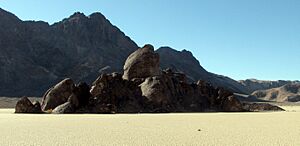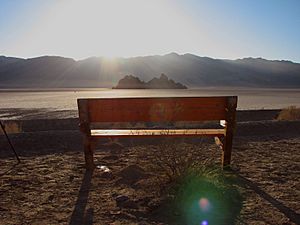The Grandstand facts for kids
Quick facts for kids The Grandstand |
|
|---|---|

The Grandstand as seen from the western entry road to the Racetrack Playa - below Teakettle Junction
|
|
| Highest point | |
| Elevation | 73 ft (22 m) |
| Geography | |
| Location | Racetrack Valley, Death Valley National Park, Inyo County, California, United States |
| Parent range | Cottonwood Mountains |
The Grandstand is a special rock formation found in Death Valley National Park in California. It's a tall, dark rock that stands out in the middle of a very flat, light-colored dry lakebed called Racetrack Playa. It's located in the Cottonwood Mountains and is a famous landmark in this unique desert area.
Contents
What is The Grandstand?
The Grandstand looks like two dark rock hills with a small dip between them. It's surrounded by the light, flat clay of Racetrack Playa. Because the rock is so dark and the ground around it is so light, The Grandstand looks almost black when the sun shines brightly. This strong contrast makes it easy to spot from far away, even from airplanes flying high above!
Where is The Grandstand Located?
The Grandstand is in the northwest part of Racetrack Playa. It's pretty much the only big feature that breaks up the flat, open space of the playa. The southern part of The Grandstand is a little taller than the northern part. It rises about 20 meters (66 feet) above the very flat ground.
Racetrack Playa itself is about 1,132 meters (3,714 feet) above sea level. It's about 4.5 kilometers (2.8 miles) long from north to south and 2.1 kilometers (1.3 miles) wide from east to west.
How The Grandstand Was Formed
The Grandstand is made of a type of rock called Quartz-Monzonite. This rock formed deep underground a very, very long time ago when hot, melted rock (magma) slowly cooled down. It's similar to granite, another common rock.
Millions of years ago, during ancient times like the Pleistocene epoch, this rock was pushed up to the surface. Other nearby mountains, like Ubehebe Peak and the Panamint Range, were also formed around the same time.
If you look closely at the south side of The Grandstand, you can see signs that water once shaped it. There's a noticeable overhang, about 30 feet above the playa surface. This shows that the Racetrack Playa area used to get a lot more rain and snow than it does today, forming a lake that eroded the rock.
Even though The Grandstand seems big when you're standing next to it, it's actually quite small compared to the huge mountains around it. It's the light-colored playa surrounding the dark rock that makes The Grandstand stand out so much.

Animals and Weather at The Grandstand
Just like the rest of Death Valley National Park, The Racetrack and The Grandstand don't get much rain, usually less than 5 centimeters (2 inches) each year. Because The Grandstand is about 914 meters (3,000 feet) high, it's a bit cooler there than on the very bottom of Death Valley. However, summer daytime temperatures can still be over 38°C (100°F)!
Winds can be very strong here because The Racetrack is a long, open valley. These strong winds are famous for moving the "sailing stones" at the south end of the playa.
Believe it or not, large birds called Great blue herons have been seen resting on top of The Grandstand during their long migrations!
Visiting The Grandstand
There are a few ways to drive to The Grandstand. The main road is Racetrack Road, which is a 43-kilometer (27-mile) gravel road. It starts near Ubehebe Crater. This road is usually okay for most cars and SUVs, but it's very rough. It's a good idea to have strong tires because the road is known for causing flat tires!
You can also reach The Grandstand from the west using Lippincott Road or Hunter Mountain Road. These roads are much rougher and should only be used by experienced drivers in special off-road vehicles.
When you get to The Grandstand, the National Park Service has a parking area and signs that tell you more about the area. There's even a bench where you can sit and enjoy the view of The Grandstand, Racetrack Playa, and the Cottonwood Mountains.
South of The Grandstand, you can find another parking area. From there, you can walk about 1.2 kilometers (3/4 mile) across the playa to see the famous "moving rocks."
The dry lakebed surface is usually firm enough to walk on. However, the park asks visitors not to walk on it when it's wet, as your footprints can damage the delicate surface. Bikes and other wheeled vehicles are never allowed on the playa.
You can't camp right on the playa, but "primitive camping" (camping without facilities) is allowed in areas north and south of it. Signs along Racetrack Road will show you where you can and cannot camp.
Other cool places nearby include Ubehebe Crater, a large volcanic crater, and the Eureka Valley Sand Dunes to the north.


